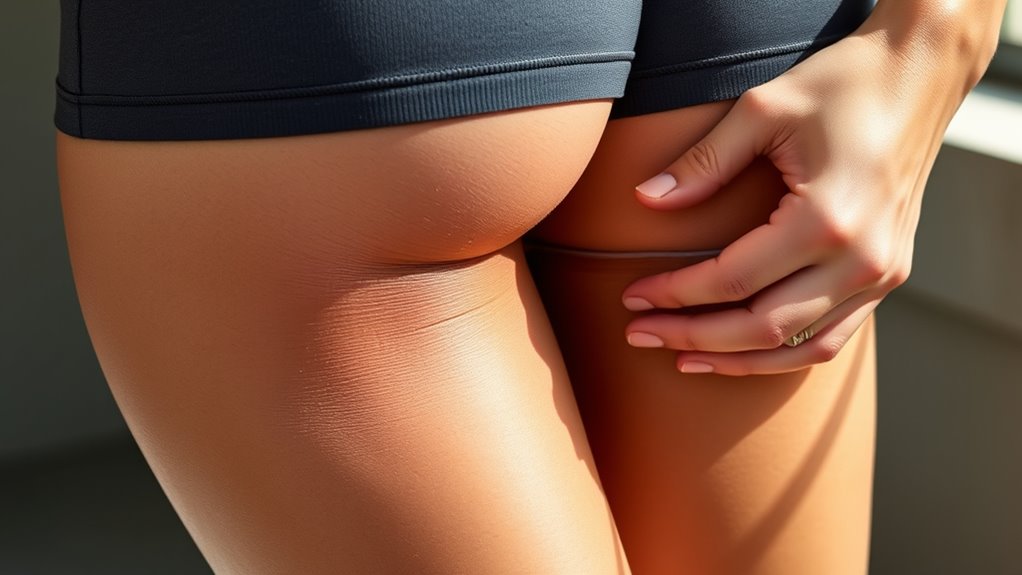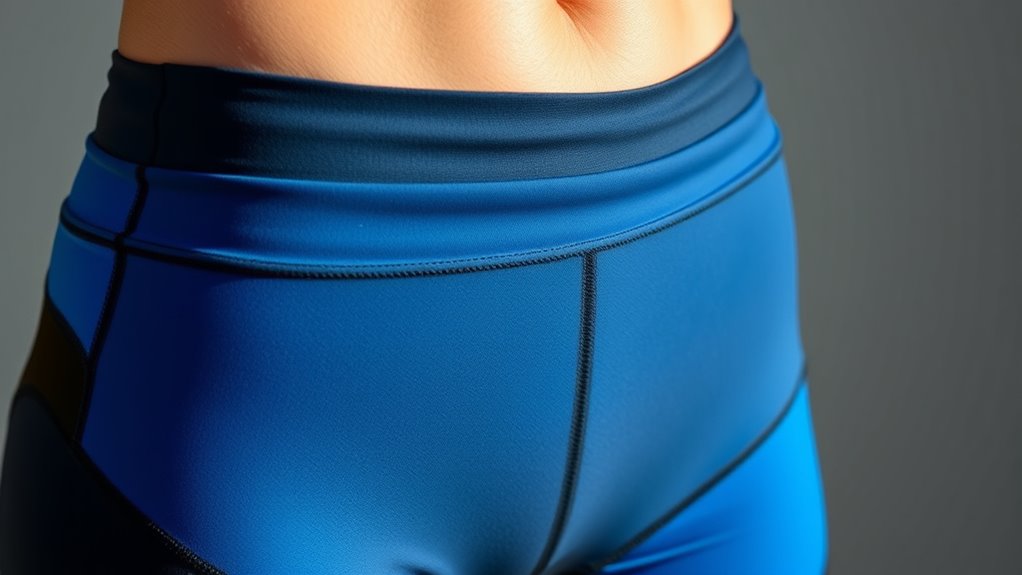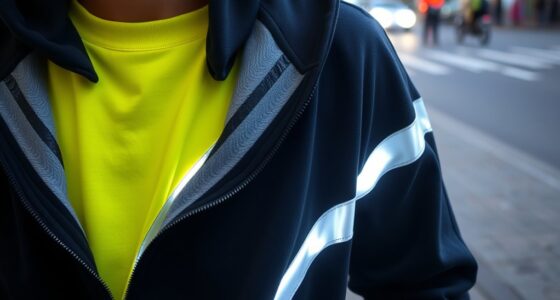To prevent chafing, choose moisture-wicking fabrics like polyester or nylon that keep your skin dry, and avoid cotton which traps sweat. Confirm your clothing fits well—neither too tight nor too loose—to reduce friction and rubbing. Apply anti-chafing balms or powders beforehand to create a protective barrier. Paying attention to fabric choices, fit, and skin prep helps minimize irritation and discomfort. Keep exploring these tips to stay comfortable during your activity.
Key Takeaways
- Choose moisture-wicking fabrics like polyester or nylon to keep skin dry and reduce friction.
- Ensure clothing fits snugly without being too tight or loose, minimizing rubbing points.
- Apply anti-chafing balms or powders before activity to create a protective barrier on the skin.
- Layer with lightweight, breathable clothing that moves smoothly and prevents bunching or chafing.
- Stay dry by managing moisture effectively, as dampness increases skin irritation and chafing risk.

Chafing occurs when skin rubs against clothing or itself, causing irritation and discomfort. To prevent this, understanding how to manage moisture and properly layer your clothing is essential. Moisture management plays a crucial role because sweat and dampness increase friction, making chafing more likely. Choose fabrics that wick moisture away from your skin, such as technical synthetics like polyester or nylon, which help keep you dry. Avoid cotton, since it absorbs sweat and stays damp longer, increasing the chance of irritation. When you stay dry, your skin is less prone to chafing, and your comfort level improves during physical activities or hot weather.
Clothing layering is also essential in chafing prevention. Properly layered clothing creates a barrier between your skin and outer garments, reducing friction. Start with a moisture-wicking base layer that fits snugly but not too tight, ensuring sweat is pulled away from your skin efficiently. Over this, you can add a lightweight, breathable layer for insulation or protection against the elements, but avoid bulky or rough materials that could cause additional friction. If you’re wearing multiple layers, make sure they don’t shift or bunch up as you move, as this can create friction points. Seamless or flat-seamed clothing is preferable because it minimizes rubbing against your skin.
In addition to choosing the right fabrics and layering correctly, consider the fit of your clothing. Tight clothing may seem to stay in place better, but it can also increase friction if it’s too restrictive or made from rough materials. Conversely, loose clothing can move around and cause chafing due to constant rubbing. The key is finding a balance—wear clothes that fit well, providing enough support without excessive tightness or looseness. When possible, opt for garments designed specifically for athletic use, which often incorporate flatlock seams and smooth fabrics to reduce friction.
Besides clothing choices, preparing your skin before activity can make a big difference. Applying an anti-chafing balm, petroleum jelly, or powders like talcum or cornstarch can create a protective barrier, especially in areas prone to chafing. These products help reduce skin-to-skin or skin-to-clothing friction and absorb excess moisture, further supporting your moisture management efforts. By paying attention to clothing layering, fabric selection, fit, and skin prep, you can considerably decrease your risk of chafing and enjoy your activities with greater comfort.
Frequently Asked Questions
How Does Hydration Impact Chafing Risk?
Staying well-hydrated reduces your chafing risk by maintaining ideal hydration levels and supporting skin elasticity. When you’re properly hydrated, your skin stays supple and less prone to irritation and friction. Drinking enough water helps prevent dryness and chafing-related discomfort, especially during physical activity. Keep up with your hydration to protect your skin’s resilience, minimize chafing, and stay comfortable during your workouts or outdoor adventures.
Are There Specific Fabrics Best for Sensitive Skin?
If you have sensitive skin, opt for fabrics that are soft, breathable, and hypoallergenic. Look for material selection like cotton, bamboo, or moisture-wicking blends, which reduce irritation and chafing. Avoid rough, synthetic, or tight-fitting fabrics that can cause discomfort. By choosing gentle, natural fibers and ensuring proper fit, you create a barrier against chafing, keeping your skin comfortable and protected during activity.
Can Diet Influence Skin Irritation and Chafing?
Yes, your diet can influence skin irritation and chafing. Diet and skin health are closely linked, as poor nutrition may lead to nutritional deficiencies that weaken your skin, making it more prone to irritation. Eating a balanced diet rich in vitamins, minerals, and hydration supports healthy skin, reducing chafing risks. Avoid processed foods and focus on foods that promote skin resilience, helping you stay comfortable during physical activities.
How Often Should Skin Be Moisturized to Prevent Chafing?
You should moisturize your skin at least once daily to maintain proper skin hydration and prevent chafing. If you’re prone to chafing or have dry skin, consider applying moisturizer twice a day, especially after bathing. Consistent moisturizer frequency helps keep your skin resilient and reduces irritation during physical activities. Remember, well-hydrated skin is less likely to chafe, so don’t skip your daily skin hydration routine.
Do Anti-Chafing Products Work Equally for Everyone?
Anti-chafing products aren’t magic bullets—what works wonders for one person might be a total flop for another. Your skin’s sensitivity and individual needs mean these products can vary wildly in effectiveness. You might find a miracle solution, or it could be a dud. It’s all about trying different options and seeing what your skin responds to best, since personalized product efficacy is key to preventing chafing.
Conclusion
To keep chafing at bay, remember the basics: choose the right fabrics, guarantee a proper fit, and prep your skin with powder or lubricant. Think of it as your secret weapon against discomfort—like a knight’s armor in a medieval joust. Stay proactive, listen to your body, and don’t forget to carry a bit of the old magic (like talcum powder) for extra protection. With these tips, you’ll stay comfortable and ready for any adventure ahead!









